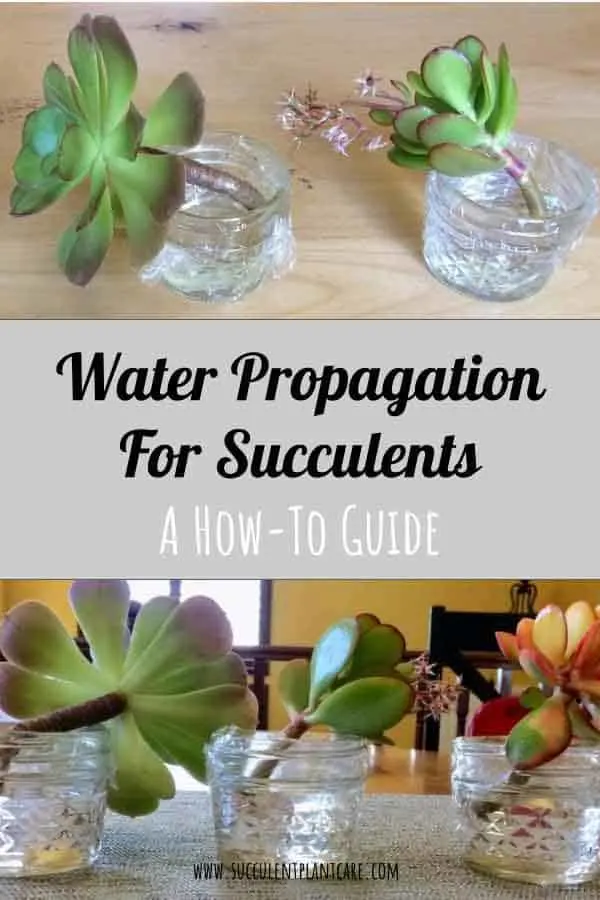What is Water Propagation?
Water propagation is using water as a medium to root succulent cuttings. This may go against conventional thinking about succulents. The common knowledge about succulent plants is they do not like to sit in water and sitting in water promotes root rot.
So water propagation might contradict what we have come to believe about caring for and propagating succulents. And yet, I’ve been hearing more and more about water propagation lately.

From what I have heard and read, some people find water propagation easier than the more ‘conventional’ methods of rooting on soil or dry medium.
I have read plenty of success stories from people who have had zero success with succulent propagation until they tried water propagation. In fact, some people only propagate succulent cuttings by the water method because they see faster results and greater success overall.
Why Succulent Cuttings Do Not Rot in Water
One theory I heard is that the reason why succulent cuttings do not rot in water is because water is not the main culprit for rot. Succulent plants sitting in wet soil are exposed to fungus and pathogens in the soil that introduce diseases to the plant, causing root rot. When propagating in water, the plants are not exposed to the pathogens normally present in the soil medium and therefore, they do not suffer from rot.
Water Roots vs. Dry Roots
Another concern people have about water propagation is that the roots formed in water are not the same roots the plant needs to grow in soil. Once planted in soil, they need to develop new roots more appropriate for growing in soil. Still, others that propagate through the water method say that the plants do just fine once transplanted from water to soil.
I for one have had great success with ‘dirt propagation’ but was curious to see how water propagation works so I set out to perform an experiment. I tried rooting three stem cuttings in water to see what happens. I chose two different plants that I have had no problems rooting in soil. I thought choosing a plant that I know is easy to propagate would give me a better success rate. I used stem cuttings from a jade plant (crassula ovata) and an aeonium (blushing beauty) plant.
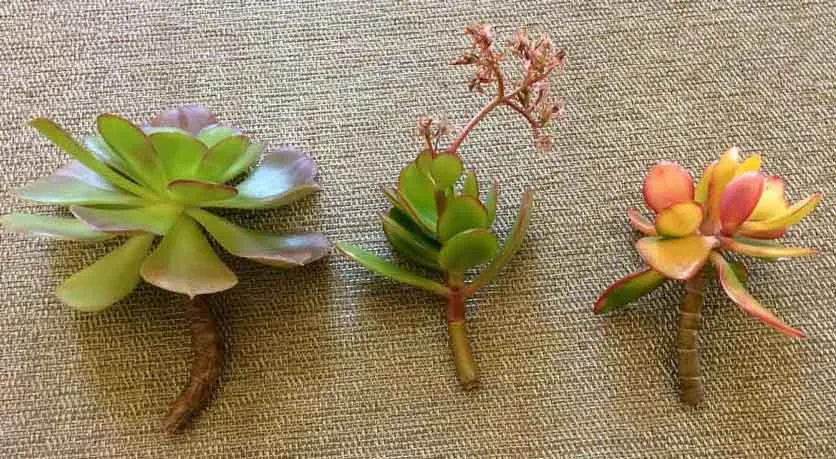
These are the three stem cuttings I started out with.
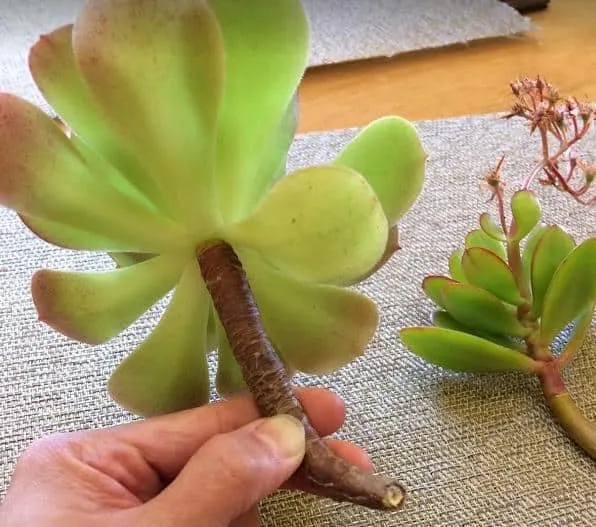
I let the cuttings dry for a few days.
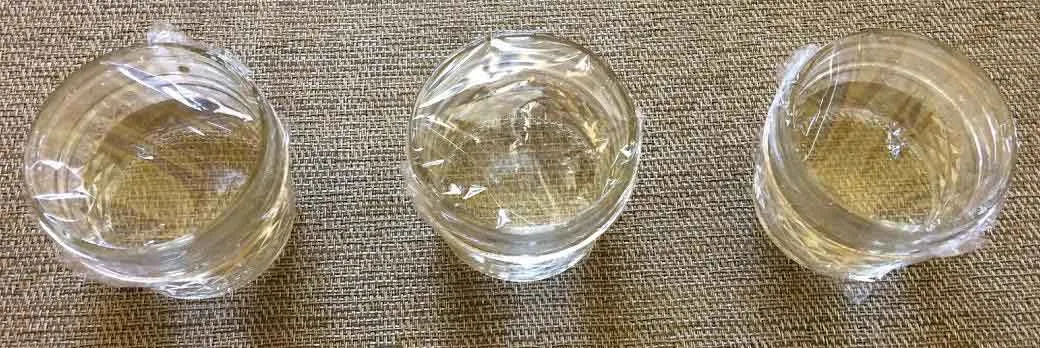
I used three mason jars and filled it with water, then covered it with clear plastic and poked holes in the middle of the plastic. I used purified drinking water we use for drinking. Some people use plain tap water. I heard of others using distilled water. I did not add any nutrients to the water. From what I read, this is not necessary.
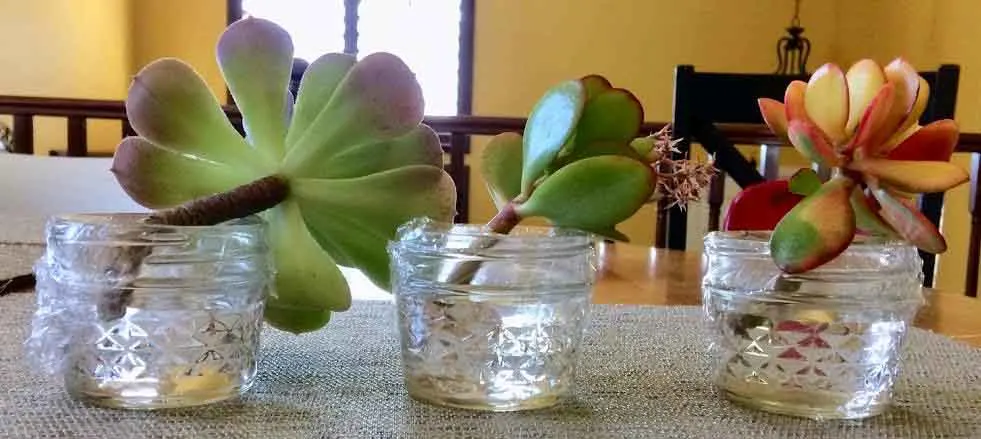
The three stem cuttings were then laid on the rim of the jar so that the tip of the stem cutting is touching the water. There’s two different methods people use when rooting in water. One method is to sit the end of the cuttings just above the surface of the water. The reason being that the cuttings will seek out moisture and start rooting. Another method is to let the ends of the cuttings actually touch the water. I chose the second method but both methods seem to work fine.
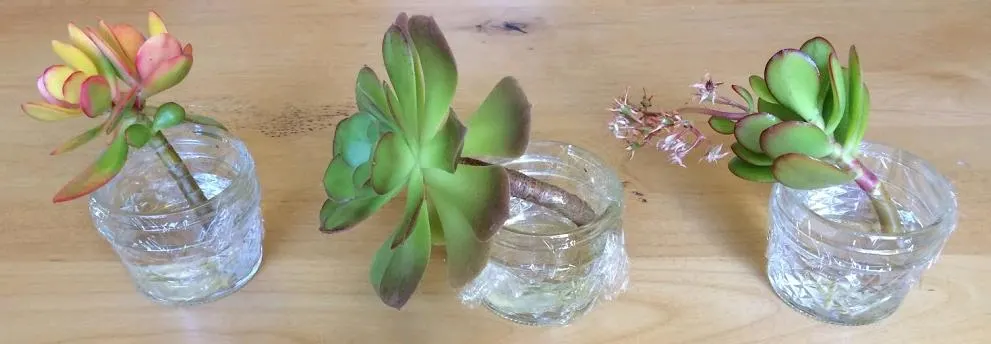
I left the cuttings in a bright area and tried to forget about them for a couple of weeks. We went on a family vacation right after this and when we came back two weeks later, the cuttings look the same as I had left them. No roots formed. The water didn’t seem like it needed to be changed or replenished so I just left them as is and kind of forgot about them.
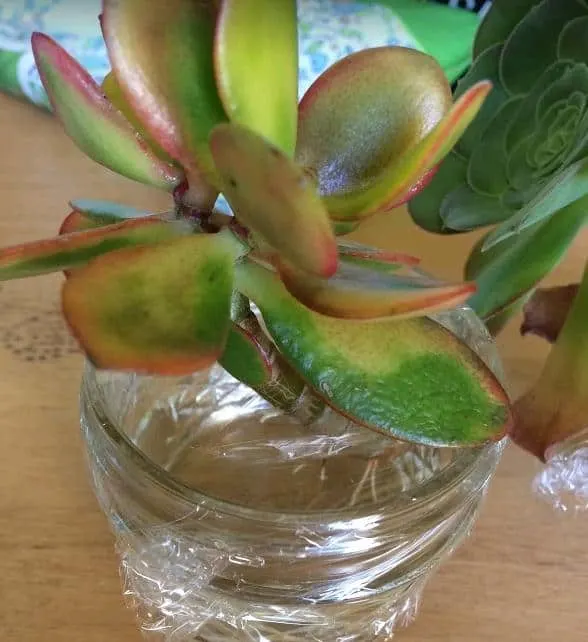
Another two weeks later (about 4 weeks total), I was surprised to see plenty of pink roots on the two jade cuttings.
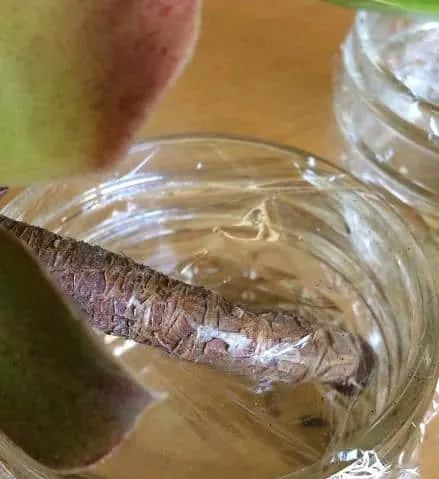
The aeonium sprouted one tiny root and that was it.
So I left the plants in water for another week or two just to see what happens.
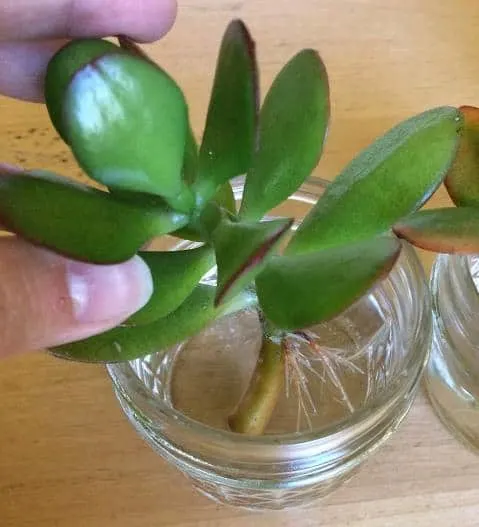
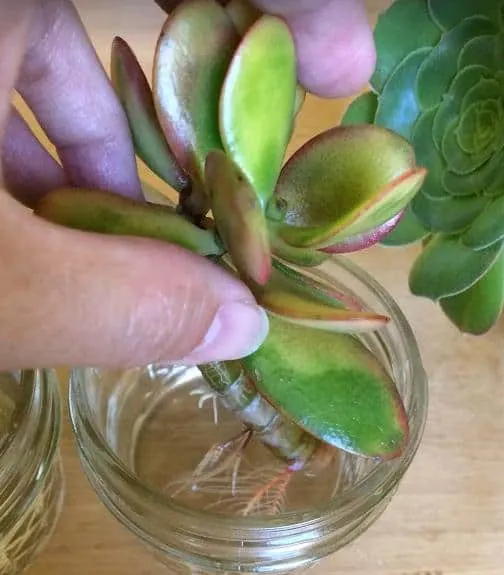
Another 2 weeks passed by (6 weeks total from the beginning of this experiment) and the jade plants grew more roots but the aeonium stayed the same.
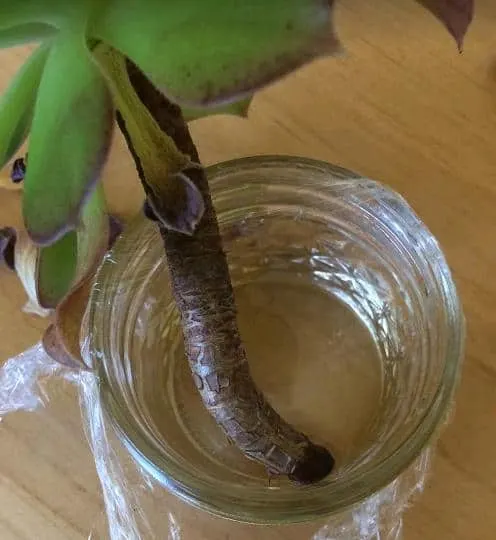
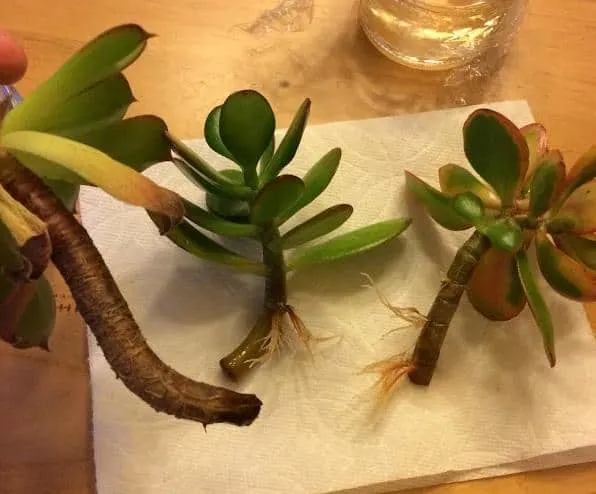
After about 6 weeks I thought it was time to transplant the rooted cuttings into soil so I took them out of the water and laid them on paper to dry for a day or so. All three stem cuttings were fine and did not rot or appear unwell.
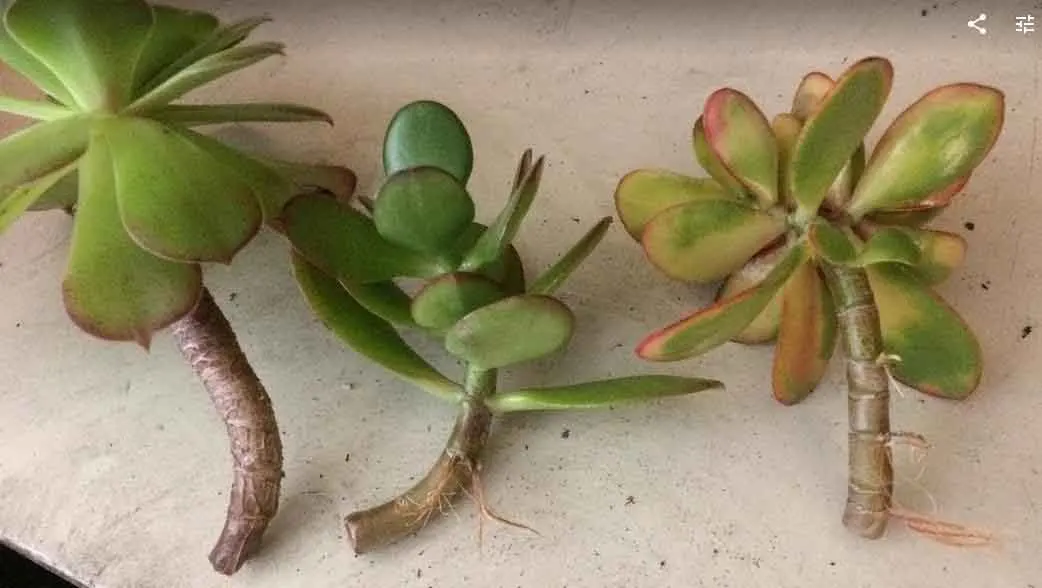
The next challenge is to see how these cuttings would survive in soil after being in water for five weeks and growing water roots. The aeonium cutting barely grew any roots after five weeks but I will plant it in soil anyway. I have had plenty of aeonium cuttings grown in soil before so I’m almost certain this will do fine once in soil.
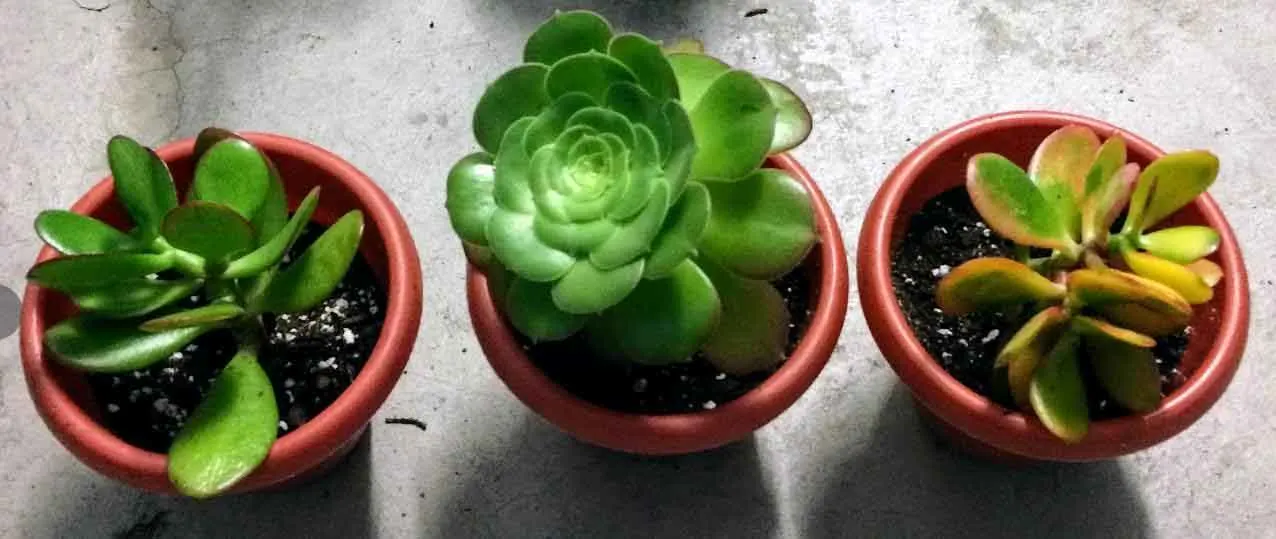
I prepared a mixture of cactus mix and perlite and placed the potting mix in little pots. The stem cuttings were then planted in the pot.
I treat these potted cuttings like I would normally treat my other stem cuttings. Keep them in a bright area but protected from intense afternoon sun or direct sunlight.
Once these plants are rooted and fully established, the amount and intensity of sunlight can be increased.
If you notice they are getting sunburned, move to a more shaded location. You can move the plants around to see where they fare best. To tell whether the cuttings have rooted, you can pull the stem out to see after about three weeks or so. If the plant does not give and is hard to pull out of the soil, that means it has rooted.
Update:
To see how these plants are doing 4 months later, please click on “Does Water Propagation Work for Succulents?” to see updates and pictures.
Here’s a Step-by-Step Guide on How to Propagate in Water:
Step 1
Get a cutting. Snip a stem cutting from a succulent plant. Plants that have become leggy can be a great source of stem cuttings. Leave about two inches or more of bare stem.
OR Instead of a stem cutting you can also use leaves, or both stems and leaves to propagate.
Choose healthy leaves. You will have better success when you start with a healthy leaf. Choose leaves that are not damaged, ripped, torn or misshapen. Look for full and plump leaves, not dehydrated and flat leaves.
Step 2
Gently remove the leaves from the stem. Using your fingers, gently twist off the leaves from the stem with your thumb and forefinger. Some leaves come off easily, some are firmly attached to the stem.
Gently wiggle the leaf back and forth until the whole leaf comes off. You want the whole leaf including the base that attaches to the stem. If the base of the leaf does not come off, or if the leaf gets damaged, it will not survive.
Step 3
Let the cuttings dry. Allow the cutting to dry for a couple of days until the cut end have calloused or dried.
Step 4
Place in water. Find a cup that is the right size for the cuttings and add water. Place the cutting so that the end of the stem or leaf is resting just above the surface of the water.
Another way people do it is to let the end of the cutting touch the water. Both methods seem to work from what I have heard. (I did the latter, where the end of the cuttings were touching the water).
Step 5
Place in a bright spot. Leave the cup in a sunny or well lit area.
Step 6
Wait for roots to grow. Add water as needed.
Step 7
Plant the rooted cuttings. Once roots have grown, allow for the cuttings to dry for a few days. Once dry, the rooted cuttings can be planted in a suitable potting mix.
Step 8
Water occasionally. Baby plants need a little more moisture than mature plants. Lightly mist the soil with a spray bottle every few days or when the soil feels dry. Once the plant is more established and rooted, decrease watering to about once a week.
Step 9
Protect from direct sunlight. Protect new plants from direct sunlight when initially planted on its own pot to prevent sun damage. Gradually increase sunlight and sun exposure according to the plant’s needs as the plant matures.
OR
Instead of planting the rooted cuttings as explained in step 7, some people choose to leave the cuttings in water. The cuttings will continue to live and survive in water indefinitely. Change the water out and replenish with fresh clean water every few weeks or as needed.
Some people have succulents growing in water hydroponically. They like how it looks and have great success with them. They can be left outdoors or indoors, with plenty of light.
My thoughts on water propagation:
Since I have had success with ‘dirt’ propagation, I do not see the need for going the water propagation route. I can see the appeal of it for others, and it does seem more straightforward. Just place the plants in water or right above water, and wait for roots to develop.
When I tried this method, it took about 4-5 weeks to see roots growing, and one plant, the aeonium cutting, didn’t really develop that much roots at all. Granted I only tried two different plants and only used stem cuttings, I may see different results with leaf cuttings or with other plant species. Also, the stem cuttings I had sitting in water for five weeks were doing just fine and did not rot or die.
Understandably, the results would probably be different for others depending on the environment you are in. Just like with dirt propagation, some people have greater success than others depending on the climate, the type of plant, etc. I definitely would not disregard this method entirely and would recommend this for others to try, even just for fun, or for those who have had no luck with the ‘dry’ method.
As I have heard and read, a lot of people prefer this route because it is faster and they have better success than with dirt propagation. So if you are looking to experiment and try something new, or you’ve tried propagating again and again but have had zero luck, this is definitely worth a try. Please click on “4 Easy Ways to Propagate Succulents” to find out about other succulent propagation methods.
